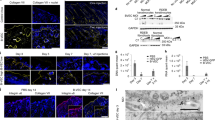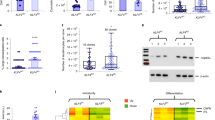Abstract
We report the isolation of a cosmid clone containing the entire human COL7A1 gene in one piece. The ability of the genomic sequences within this clone to direct tissue-specific expression of human collagen VII in transgenic mice was tested. The data show that the gene construct is capable of directing expression of collagen VII in the skin of fetal and neonatal transgenic mice. Expression of COL7A1 in these mice was widespread, in a pattern consistent with that found in human tissues and was in parallel with that of the endogenous mouse gene. Immunostaining, using human-specific antibodies, showed that human collagen VII protein was present at the skin basement membrane zone of the transgenic mice. Dermal extracts from 19-month-old transgenic mice contained mature human collagen VII protein, and fibroblasts derived from skin biopsies of these mice actively synthesized human collagen VII. The demonstration of successful and stable expression of human collagen VII in in vivo gene transfer is the first step towards the future development of therapeutic protocols for the rescue of keratinocyte function in severe blistering diseases such as dystrophic epidermolysis bullosa.
This is a preview of subscription content, access via your institution
Access options
Subscribe to this journal
Receive 12 print issues and online access
$259.00 per year
only $21.58 per issue
Buy this article
- Purchase on Springer Link
- Instant access to full article PDF
Prices may be subject to local taxes which are calculated during checkout




Similar content being viewed by others
References
Burgeson RE . Type VII collagen, anchoring fibrils and epidermolysis bullosa J Invest Dermatol 1993 101: 252–255
Shimizu H et al. Immunohistochemical, ultrastructural, andmolecular features of Kindler syndrome distinguish it from dystrophic epidermolysis bullosa Arch Dermatol 1997 133: 1111–1117
Bruckner-Tuderman L . Hereditary skin diseases of anchoring fibrils J Dermatol Sci 1999 20: 122–133
Bruckner-Tuderman L, Hopfner B, Hammami-Hauasli N . Biology of anchoring fibrils: lessons from dystrophic epidermolysis bullosa Matrix Biol 1999 18: 43–54
Bruckner-Tuderman L et al. Immunohistochemical and mutation analyses demonstrate that procollagen VII is processed to collagen VII through removal of the NC-2 domain J Cell Biol 1995 131: 551–559
Christiano AM et al. Structural organization of the human type VII collagen gene (COL7A1), composed of more exons than any previously characterized gene Genomics 1994 21: 169–179
Christiano AM, Greenspan DS, Lee S, Uitto J . Cloning of human type VII collagen. Complete primary sequence of the alpha 1(VII) chain and identification of intragenic polymorphisms J Biol Chem 1994 269: 20256–20262
Li K et al. cDNA cloning and chromosomal mapping of the mouse type VII collagen gene (Col7a1): evidence for rapid evolutionary divergence of the gene Genomics 1993 16: 733–739
Kivirikko S, Li K, Christiano AM, Uitto J . Cloning of mouse type VII collagen reveals evolutionary conservation of functional protein domains and genomic organization J Invest Dermatol 1996 106: 1300–1306
McGrath JA et al. Structural variations in anchoring fibrils in dystrophic epidermolysis bullosa: correlation with type VII collagen expression J Invest Dermatol 1993 100: 366–372
Heagerty AH et al. Identification of an epidermal basement membrane defect in recessive forms of dystrophic epidermolysis bullosa by LH 7:2 monoclonal antibody: use in diagnosis Br J Dermatol 1986 115: 125–131
Leigh IM et al. Type VII collagen is a normal component of epidermal basement membrane, which shows altered expression in recessive dystrophic epidermolysis bullosa (published erratum appears in J Invest Dermatol 1989; 92: 135) J Invest Dermatol 1988 90: 639–642
Bruckner-Tuderman L et al. Lack of type VII collagen in unaffected skin of patients with severe recessive dystrophic epidermolysis bullosa Dermatologica 1988 176: 57–64
Bruckner-Tuderman L, Mitsuhashi Y, Schnyder UW, Bruckner P . Anchoring fibrils and type VII collagen are absent from skin in severe recessive dystrophic epidermolysis bullosa J Invest Dermatol 1989 93: 3–9
Pulkkinen L, Uitto J . Mutation analysis and molecular genetics of epidermolysis bullosa Matrix Biol 1999 18: 29–42
Heinonen S et al. Targeted inactivation of the type VII collagen gene (Col7a1) in mice results in severe blistering phenotype: a model for recessive dystrophic epidermolysis bullosa J Cell Sci 1999 112: 3641–3648
Ghazizadeh S, Harrington R, Taichman L . In vivo transduction of mouse epidermis with recombinant retroviral vectors: implications for cutaneous gene therapy Gene Therapy 1999 6: 1267–1275
Uitto J, Chung Honet LC, Christiano AM . Molecular biology and pathology of type VII collagen Exp Dermatol 1992 1: 2–11
Uitto J, Christiano AM . Dystrophic forms of epidermolysis bullosa Semin Dermatol 1993 12: 191–201
Wetzels RHW et al. Distribution patterns of type VII collagen in normal and malignant human tissues Am J Pathol 1991 139: 451–459
Leigh I, Purkis PE, Bruckner-Tuderman L . LH 7.2 monoclonal antibody detects type VII collagen in the basement membranes of ectodermally derived epithelia including skin Epithelia 1987 1: 17–29
Leivo I et al. Anchoring complex components laminin-5 and type VII collagen in intestine: association with migrating and differentiating enterocytes J Histochem Cytochem 1996 44: 1267–1277
Nagle RB et al. Expression of hemidesmosomal and extracellular matrix proteins by normal and malignant human prostate tissue Am J Pathol 1995 146: 1498–1507
Paulus W et al. Expression of type VII collagen, the major anchoring fibril component, in normal and neoplastic human nervous system Virch Arch 1995 426: 199–202
Ryynanen J et al. Type VII collagen gene expression in human umbilical tissue and cells Lab Invest 1993 69: 300–304
Khavari PA . Gene therapy for genetic skin disease J Invest Dermatol 1998 110: 462–467
Sawamura D et al. In vivo transfer of a foreign gene to keratinocytes using the hemagglutinating virus of Japan–liposome method J Invest Dermatol 1997 108: 195–199
Braun-Falco M, Doenecke A, Smola H, Hallek M . Efficient gene transfer into human keratinocytes with recombinant adeno-associated virus vectors Gene Therapy 1999 6: 432–441
Vailly J et al. Corrective gene transfer of keratinocytes from patients with junctional epidermolysis bullosa restores assembly of hemidesmosomes in reconstructed epithelia Gene Therapy 1998 5: 1322–1332
Seitz CS et al. BP180 gene delivery in junctional epidermolysis bullosa Gene Therapy 1999 6: 42–47
Sokolov BP et al. Tissue-specific expression of the gene for type I procollagen (COL1A1) in transgenic mice. Only 476 base pairs of the promoter are required if collagen genes are used as reporters J Biol Chem 1995 270: 9622–9629
Swift GH, Kruse F, MacDonald RJ, Hammer RE . Differential requirements for cell-specific elastase I enhancer domains in transfected cells and transgenic mice Genes Dev 1989 3: 687–696
Leung KKH et al. Different cis-regulatory DNA elements mediate developmental stage- and tissue-specific expression of the human COL2A1 transgene J Cell Biol 1998 141: 1291–1300
Darnell JEJ . Variety in the level of gene control in eukaryotic cells Nature 1982 297: 365–371
Gutman A, Gilthorpe J, Rigby PW . Multiple positive andnegative regulatory elements in the promoter of the mouse homeobox gene Hoxb-4 Mol Cell Biol 1994 14: 8143–8154
Bonifer C et al. Prerequisites for tissue specific and position independent expression of a gene locus in transgenic mice J Mol Med 1996 74: 663–671
Chen M et al. Corrective gene transfer in dystrophic epidermolysis bullosa J Invest Dermatol 1999 112: 552 (Abstr. 175)
Fine JD, Bauer EA, McGuire J, Moshell A . Epidermolysis Bullosa: Clinical, Epidemiologic and Laboratory Advances, and the Findings of the National Epidermolysis Bullosa Registry Johns Hopkins University Press: Baltimore 1999
Deng H, Lin Q, Khavari PA . Sustainable cutaneous gene delivery Nat Biotechnol 1997 15: 1388–1391
Krueger GG, Morgan JR, Petersen MJ . Biologic aspects of expression of stably integrated transgenes in cells of the skin in vitro and in vivo Proc Assoc Am Phys 1999 111: 198–205
Kolodka TM, Garlick JA, Taichman LB . Evidence forkeratinocyte stem cells in vitro: long term engraftment and persistence of transgene expression from retrovirus-transduced keratinocytes Proc Natl Acad Sci USA 1998 95: 4356–4361
Pellegrini G, Bondanza S, Guerra L, De Luca M . Cultivation of human keratinocyte stem cells: current and future clinical applications Med Biol Eng Comput 1998 36: 778–790
Bickenbach JR, Roop DR . Transduction of a preselected population of human epidermal stem cells: consequences for gene therapy Proc Assoc Am Phys 1999 111: 184–189
Cotsarelis G et al. Epithelial stem cells in the skin: definition, markers, localization and functions Exp Dermatol 1999 8: 80–88
Rudnicka L et al. Elevated expression of type VII collagen in the skin of patients with systemic sclerosis. Regulation bytransforming growth factor-beta J Clin Invest 1994 93: 1709–1715.
Gobet R et al. Efficacy of cultured epithelial autografts inpediatric burns and reconstructive surgery Surgery 1997 121: 654–661
Raghunath M et al. Cross-linking of the dermo–epidermal junction of skin regenerating from keratinocyte autografts. Anchoring fibrils are a target for tissue transglutaminase J Clin Invest 1996 98: 1174–1184
Prockop DJ, Kivirikko KI . Collagens: molecular biology, diseases, and potentials for therapy Annu Rev Biochem 1995 64: 403–434
Hengge UR et al. Efficient expression of naked plasmid DNA in mucosal epithelium: prospective for the treatment of skin lesions J Invest Dermatol 1998 111: 605–608
Vogel JC . A direct in vivo approach for skin gene therapy Proc Assoc Am Phys 1999 111: 190–197
Fan H, Lin Q, Morrissey GR, Khavari PA . Immunization via hair follicles by topical application of naked DNA to normal skin Nat Biotechnol 1999 17: 870–872
Weiss EH et al. Isolation and characterization of a human collagen alpha 1(I)-like gene from a cosmid library Nucleic Acids Res 1982 10: 1981–1994
Fuller F, Boedtker H . Sequence determination and analysis of the 3′ region of chicken pro-alpha 1(I) and pro-alpha 2(I) collagen messenger ribonucleic acids including the carboxy-terminal propeptide sequences Biochemistry 1981 20: 996–1006
Kioussis D et al. Expression and rescuing of a cloned human tumour necrosis factor gene using an EBV-based shuttle cosmid vector EMBO J 1987 6: 355–361
Hogan B, Costantini F, Lacy E . Manipulating the Mouse Embryo: A Laboratory Manual Cold Spring Harbor Laboratory: New York 1986
Lovell-Badge RH . Introduction of DNA into embryonic stem cells. In: Robertson EJ (ed) Teratocarcinomas and Embryonic Stem Cells – A Practical Approach IRL Press: Oxford 1987 pp 153–182
Bruckner-Tuderman L, Schnyder UW, Winterhalter KH, Bruckner P . Tissue form of type VII collagen from human skin and dermal fibroblasts in culture Eur J Biochem 1987 165: 607–611
Hintner H et al. Immunofluorescence mapping of antigenic determinants within the dermal–epidermal junction in the mechanobullous diseases J Invest Dermatol 1981 76: 113–118
Acknowledgements
This study was supported by research grants from the Dystrophic Epidermolysis Bullosa Research Association (DEBRA), The University of Hong Kong Committee for Research and Conference Grants, the Hong Kong Research Grants Council-DAAD Joint Research Scheme and the German Research Council (DFG, grants Br 1475/2–3 and SFB 492/A3). We are also very grateful for skilled technical assistance from Sandra YY Wong and Margit Schubert.
Author information
Authors and Affiliations
Rights and permissions
About this article
Cite this article
Sat, E., Leung, K., Bruckner-Tuderman, L. et al. Tissue-specific expression and long-term deposition of human collagen VII in the skin of transgenic mice: implications for gene therapy. Gene Ther 7, 1631–1639 (2000). https://doi.org/10.1038/sj.gt.3301281
Received:
Accepted:
Published:
Issue Date:
DOI: https://doi.org/10.1038/sj.gt.3301281



